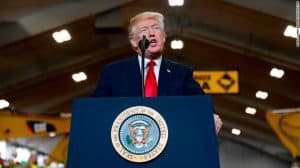
An Iowa pig farm that ships breeding stock to China (Scott Olson-Getty Images)
Founders Broadsheet trade correspondent L.C. reports:
Late Sunday April 1st, China announced that effective immediately it will be imposing tariffs of 25% on eight US exports, including pork, and 15% on one hundred and twenty other US exports, including fruits. This is China’s response to President Trump’s Section 232 (defense-related) steel and aluminum tariffs announced several weeks ago. The value of US imports affected is only $3 bn, so the Chinese response has been regarded as moderate rather than an escalation. Still, the tariffs target Midwest farmers and some sensitive products, including frozen pork and scrap aluminum, though not soybeans. Beijing said the action is being taken “to safeguard China’s interests and balance the losses caused by the US additional tariffs.”
The US is also pursuing complaints against China in the World Trade Organization (WTO) and is expected by April 6th to announce up to $60 billion in tariffs against Chinese imports under Section 301 of US trade law.
US stock markets were down two percent on the Monday following the Chinese tariff announcement.
South Korea
The US and South Korea came to a sudden agreement in their negotiations to amend the US-South Korea Free Trade Agreement (KORUS). This came about when the US dropped the tough demands that had prompted it to seek the talks in the first place. The two countries had an added incentive to reach a deal. Their close security cooperation is crucial given the impending meetings between their leaders and North Korea’s Kim Jong-un. South Korean officials were quoted this week saying that this consideration was the key motivator for reaching a quick agreement.
The deal is based on a simple trade-off: Korea agreed to impose a quota on its steel exports to the US and to tweak some parts of the original KORUS agreement to make them more favorable to the US. The US agreed to exempt South Korea from the 25% tariff it has imposed on steel imports and to drop its demands for wider KORUS revision
The agreement was generally greeted with relief by pro-trade forces, who were happy that the White House had climbed down from its fifty demands — several entirely unacceptable to Seoul — that were originally tabled under threat of the US pulling out of KORUS. Most observers said the deal was just some tweaks.

President Trump speaks several days ago at a union rally in Ohio. (AP/Pablo Martinez)
But the President later threatened at an Ohio rally that he might not sign the agreement if South Korea’s President Moon Jae-in conceded too much to North Korea. At the same Ohio rally, the President blasted all US trade agreements with friendly countries: “They’ve stolen our wealth, they’ve stolen our jobs, they’ve stolen our plants and factories. No more. We’re not letting other countries take advantage of us – even our friends. Frankly, our friends did more damage to us than our enemies…”
Korea was the first trading partner to exchange the tariffs for an export quota. The tariffs were imposed on March 23rd but suspended until May 1st for Korea, the EU, Canada, Mexico, Australia, Argentina, and Brazil. This was to give them a chance to cut a deal with Washington. For Canada and Mexico, the Administration obviously wants to win concessions in the NAFTA renegotiation. US goals for other countries are less clear, since the US runs a trade surplus with Australia, Argentina, and Brazil. But the South Korean deal is intended to be a model: voluntary export quotas, especially from countries like South Korea that import raw steel from China and thus pose a possible transshipment risk.
Japan
Japan continued this week to lobby for an exemption to the US steel and aluminum tariffs. Surprisingly, Japan was not given the May 1st postponement the US accorded to seven other countries. Not only is Japan arguably the US’s closest strategic and military ally, but it is particularly relevant to the North Korea crisis as well as US relations with Asia and efforts to contain China’s ambitions. Moreover, Japan joined the EU last December in inviting the US to launch a trilateral initiative to jointly tackle Chinese trade abuses in international forums. Recently Japan has taken the lead for a new “quad” initiative consisting of the US, Japan, India, and Australia and aimed at giving countries in the region an alternative to China’s Belt & Road Initiative.
With many reasons to take special care of Japan in granting exemptions from the tariffs, there was speculation last week that an exemption was not offered because the White House wanted to pressure Tokyo to agree bilateral Free Trade Agreement (FTA) talks. In response, Deputy Prime Minister Taro Aso was blunt in continuing to reject the idea. Speaking at the Diet (Japanese Parliament) on March 29th, he said “What’s most important is that we don’t allow the US to use the tariffs to draw Japan into bilateral FTA talks.” The following day he told reporters, “After the war, the US set up a multilateral trading system – not a bilateral one – and the whole world is moving in that direction. But recently… they’re looking to do things bilaterally. We don’t want talks like that…. We want to avoid the current talks on aluminum and steel becoming bilateral trade discussions.”
European Union and Canada
There are reports that the EU is split over how to respond to the US tariffs, with France pushing a hardline and no concessions while Germany and Italy are leading the countries worried about a trade war and eager to work with the US to avoid one.
Canada had a different response this week, one seen here as a friendly gesture toward the US. Prime Minister Justin Trudeau announced on March 27th the new steps Ottawa is taking to prevent transshipment through Canada to the US or diversion to Canada from the US of steel and aluminum now subject to US tariffs. The anti-transshipment measure is welcome in Washington and there is speculation it may help Canada reach a quota deal even if the NAFTA talks don’t conclude soon.
Accusing China but talking with it

US Trade Representative (USTR) Robert Lighthizer
The US filed a World Trade Organization (WTO) complaint against China’s abusive intellectual property, technology transfer, and innovation practices. This is the third prong of the actions the President unveiled last week in response to US Trade Representative Lighthizer’s Section 301 report. The other actions are tariffs and investment restrictions, details to be announced.
The list of imports from China to be hit with tariffs – besides aluminum and steel — was not released this week as expected but will be published soon because the deadline is April 6th. Publication will be followed by a 60-day comment period, up from the originally set 30-days, probably with the hope that a negotiated solution can be found before tariffs are imposed.
While the Section 301 tariffs could lead to tit-for-tat retaliation, the US and China may find a negotiated solution instead. It is significant that Washington turned to the WTO to correct some of the abuses identified in the Section 301 report. The US did not, however, take Tokyo and Brussels up on their suggestion that the three complain jointly about China’s abuses, though these countries could still join the complaint or support the US as third parties.
However, some observers question whether the US case is strong and likely to be won. The issue isn’t whether China forces US companies to transfer intellectual property and technology to Chinese entities as a condition for being allowed to operate there. The question is whether this can be proven and shown to violate WTO rules.
The USTR Section 301 Report runs about 200 pages and identifies myriad restrictive and discriminatory policies, but the WTO case targets just five main laws or regulations that it claims break WTO rules on national treatment and patent protection. Thus most of the USTR Report’s findings seem to fall outside of WTO rules and can therefore be tackled outside of the WTO.
Will US get the concessions it really needs?
A bigger concern is that Beijing will meet US demands, but the demands will miss the crucial target. What the US should aim for — the real problem identified in the Section 301 report — is China’s conducting an industrial policy of supporting high technology “national champions” such as artificial intelligence (AI) and robotics. The worry is that the US will declare victory if it wins more market access in sectors such as automobiles, semiconductors, and services and prevents Chinese restrictions on US farm exports.
President Trump’s focus on cutting $100 billion from the bilateral trade imbalance is almost surely an impossible goal (short of a recession) given Washington’s fiscal policies, but a trade balance focus is misplaced if the important objective is to not cede technological dominance to the Chinese.
Sources also express concern that if the US does impose the tariffs on China threatened under Section 301, the main losers will be other Asian countries and even the US, as the electronics products expected to top the US hit list are largely just assembled in China from capital-intensive inputs purchased primarily from, Taiwan, South Korea, and the US.
Another negative dimension to US unilateral action against China, adding more pressure for a negotiated settlement, is that the US may have more to lose. China can easily target politically important US exports – soybeans, aircraft – and US consumers would suffer from any cutback in imports of Chinese goods. Beijing can also inflict pain on US companies operating in China, many of whom depend on the Chinese market despite the problems they encounter there.
Click here to go to the previous Founders Broadsheet post (“China’s totalitarian dictatorship under Chairman Xi aims for world domination”)

Leave a Reply